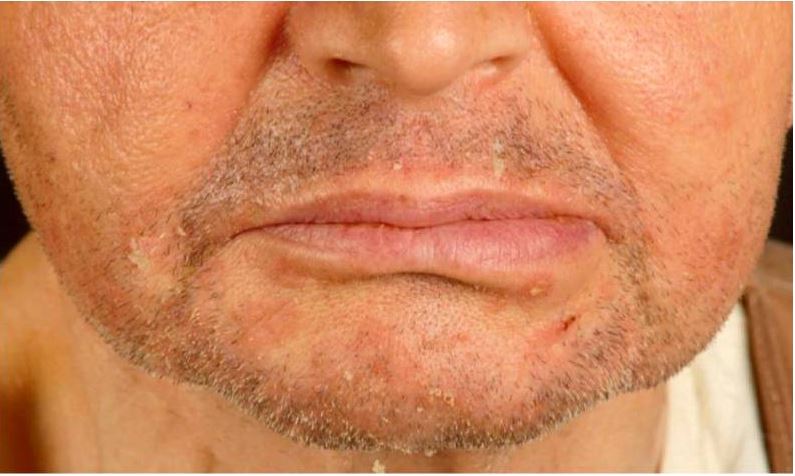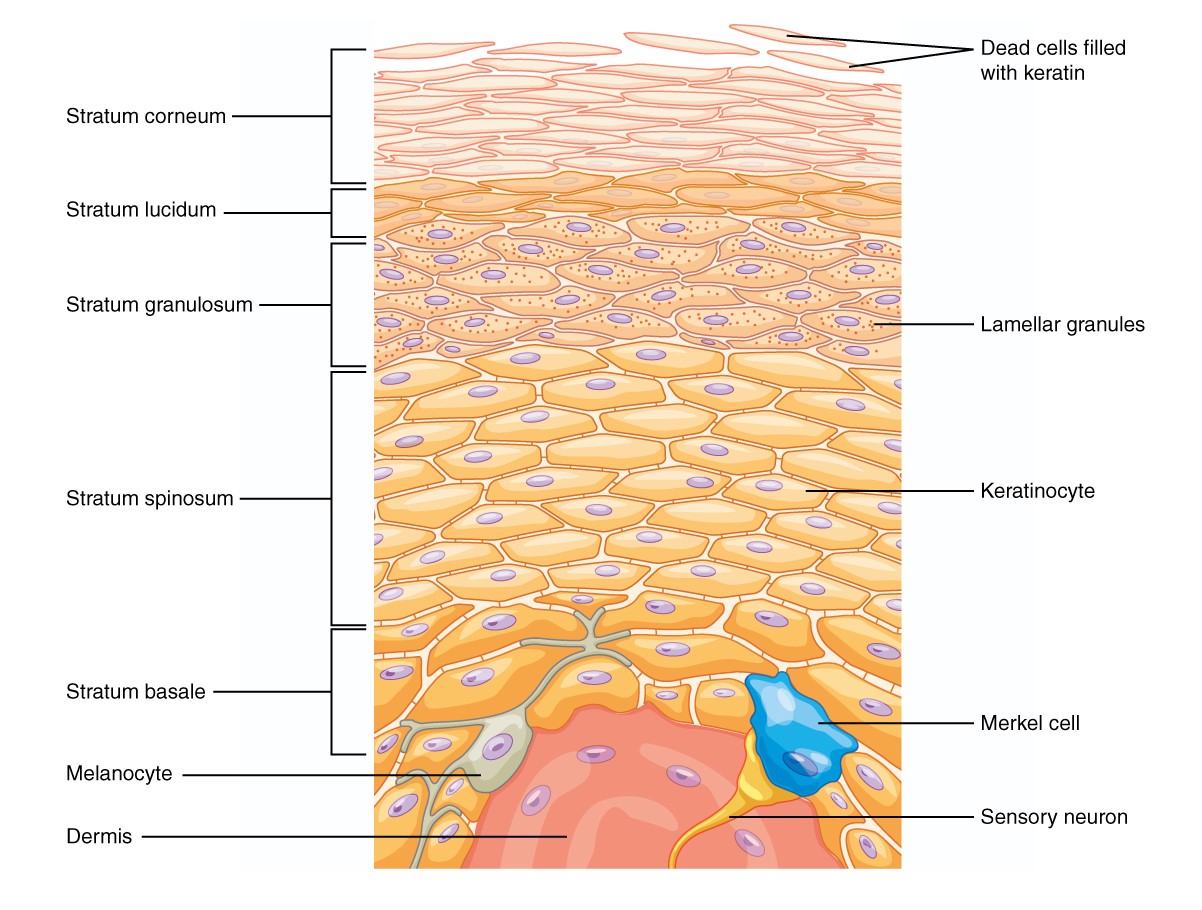Playlist
Show Playlist
Hide Playlist
Seborrheic Dermatitis
-
Slides Dermatology Inflammatory Skin Diseases.pdf
-
Download Lecture Overview
00:01 Our topic here is seborrheic dermatitis. 00:03 I want you to take a look at our patient right off the bat. 00:06 You’ll notice that, oh my goodness, do not confuse this with malar rash of SLE. 00:12 Do not confuse this with rhinophyma of rosacea, or maybe even perhaps acne, but the patient looks a little bit older. 00:19 So, the things that you want to keep in mind, as soon as you see this picture, is that, well, could it be rosacea? Could it be acne vulgaris? Could it be the malar rash of SLE, right? Let’s talk about seborrheic dermatitis, dermatitis, dermatitis. 00:36 Why do I repeat that? Because I don’t want you to get this confused with seborrheic keratosis. 00:43 You’ve heard of seborrheic keratosis in reference to Leser-Trélat sign. 00:48 It has nothing to do with this. 00:50 Could I be any more emphatic? Description for seborrheic dermatitis by reflex, greasy, yellow scale. 00:58 Doesn’t it look greasy? Maybe yellowish in terms of scale. 01:03 Sure, there is erythema as well. 01:05 May involve the nasolabial area. 01:08 Give me a condition where the nasolabial fold was not involved? Was it SLE? Or was it rosacea? SLE is not going to involve the nasolabial fold. 01:22 Why? Because we will talk about photo type of sensitivity. 01:26 So, it may involve the nasolabial area, eyebrows, scalp and chest. 01:31 These are big areas. 01:33 Infants. 01:34 So, if you have an infant that is going to present with seborrheic dermatitis, may present like dandruff, huh? It may present like dandruff. 01:42 And therefore, we call this a cradle cap because the involvement in an infant would be exactly that on the scalp. 01:50 The management here, maybe antifungal creams or washes or mild topical steroids tend to be quite effective. 02:00 With seborrheic dermatitis, what’s the etiology? Aberrant reaction. 02:05 And here, we have a particular yeast, and we call this pityrosporum. 02:10 Hence, the management we talked about earlier could be something like antifungal or steroid, topical steroid. 02:18 Ranges from simple “dandruff,” especially in that infant that we talked about cradle cap, which is yellow and greasy. 02:26 And with this type of dermatitis, you have flaking on the scalp. 02:30 So therefore, it would appear as dandruff, and hopefully, in that infant, that is as far as it goes. 02:38 Demographics here: well, if 80% of your dermatologic conditions was acne vulgaris, then all the rest will comprise the 10% to 15%. 02:48 And that’s where we have seborrheic dermatitis. 02:51 Increases with age, the demographics. 02:57 The differential diagnoses here: So here, we’ll take a look at psoriasis as being a differential for seborrheic dermatitis. 03:05 Keep in mind that picture. 03:06 With psoriasis, when I show you a picture quite dramatically, you will see that you’ll be able to clearly see that it cannot be seborrheic dermatitis. 03:15 With psoriasis, you’re going to find this salmon-colored plaque. 03:19 And with plaque, obviously, it’s going to be an elevation and it’s a flat-like elevation. 03:25 Generally, more scale, less waxy. 03:28 Where is it if it’s seborrheic dermatitis? What is the description that you give it automatically? Greasy, yellow, waxy type of appearance. 03:36 With psoriasis, often involves skin outside of the seborrheic areas. 03:41 So, what have we talked about seborrheic areas? We talked about the nasolabial fold, talked about the scalp, and maybe perhaps the chest. 03:51 At some point in time, we’ll talk about superficial dermatomycosis. 03:54 In other words, the superficial fungal infections of the skin. 03:59 Tinea is a huge deal in the U.S. 04:02 You’ve heard of one of the most common, which includes your, let’s say, tinea jock itch. 04:09 You’ve heard it before. 04:11 So, that would be inguinal. 04:12 Or underneath the nail, tinea unguium. 04:15 And elsewhere there, we’ll talk about with tineas. 04:18 Here, maybe tinea capitis. 04:21 Why? The cap means what you put on top of your head. 04:25 So therefore, this fungal infection will be taken place off the scalp. 04:29 So, how could you rule it out? Not usually so diffuse in involvement with tinea capitis. 04:36 Pretty much restricted to the scalp. 04:38 Tinea often with bogginess or significant scalp inflammation, and keep in mind that when you’re dealing with such superficial dermatomycosis, is that we will be investigating the actual fungi further. 04:54 Differential diagnosis with dermatitis: acute, acute systemic lupus. 05:00 Now, with acute systemic lupus, which I’ll show you a picture of, tends to involve the maxillary skin Spares the actual, once again where? Nasolabial fold. 05:12 The opposite of seborrheic dermatitis. 05:14 I’ve mentioned that a few times now. 05:16 Please don’t miss this particular point. 05:18 That is a huge clinical pearl. 05:21 And what about rosacea? What’s my triggers? Stress, spicy food, maybe alcohol, maybe sun, maybe wind, maybe hot temperatures, right? They’re triggers. 05:33 And if it’s a male, most likely affecting the nose, rhinophyma. 05:37 And you must find telangiectasia. 05:39 Don’t forget that because it, actually, is going to be a point of management, isn’t it? Usually limited to the central face with a background of telangiectasia. 05:50 These are differential diagnoses for seborrheic dermatitis. 05:53 Isn’t it nice now that just with a few conditions that we’ve walked through, in which I’m giving you a list of differentials, your knowledge of dermatology is already increasing by leaps and bounds? You keep doing this over and over again, you’ll be in fantastic shape for dermatology, and actually, any pathology.
About the Lecture
The lecture Seborrheic Dermatitis by Carlo Raj, MD is from the course Inflammatory Skin Diseases.
Included Quiz Questions
A 50-year-old man patient presents with a yellowish rash that involves his chest, nasolabial area, and eyebrows. The rash has responded well to an antifungal wash. What is the most likely diagnosis?
- Seborrheic dermatitis
- Tinea barbae
- Psoriasis
- Discoid lupus
- Rosacea
Which of the following descriptions best fits the lesions in plaque psoriasis?
- Dry, raised plaques covered with silvery scale and commonly found on elbows, knees, the lower back, and the scalp
- Greasy, yellow rash affecting oily areas of the body, such as the face, sides of the nose, eyebrows, ears, eyelids, and chest
- Bullous lesions affecting elbows, knees, the lower back, and the scalp
- Erythematous papules and pustules
- Flaky, red patches with scattered papules and pustules
What skin condition on the face has erythematous lesions and gets worse with spicy food, hot drinks, or alcohol?
- Rosacea
- Acute systemic lupus
- Tinea capitis
- Seborrheic dermatitis
- Impetigo
Customer reviews
4,2 of 5 stars
| 5 Stars |
|
4 |
| 4 Stars |
|
1 |
| 3 Stars |
|
0 |
| 2 Stars |
|
0 |
| 1 Star |
|
1 |
Thanks for emphasizing thing like sparing nasolabial folds. I think it is extremely important to emphasize valuable high-yield thing for better remembering.
no pathophysiology, epidemiology and risks explained explanations are shallow, very hastily spoken and with very little extra info. Not happy with this course
Belabors the points quite succinctly! The approach is just the best for clinical dermatology!
very good and informative lecture. thank you for good explanation associated with the differential diagnosis





